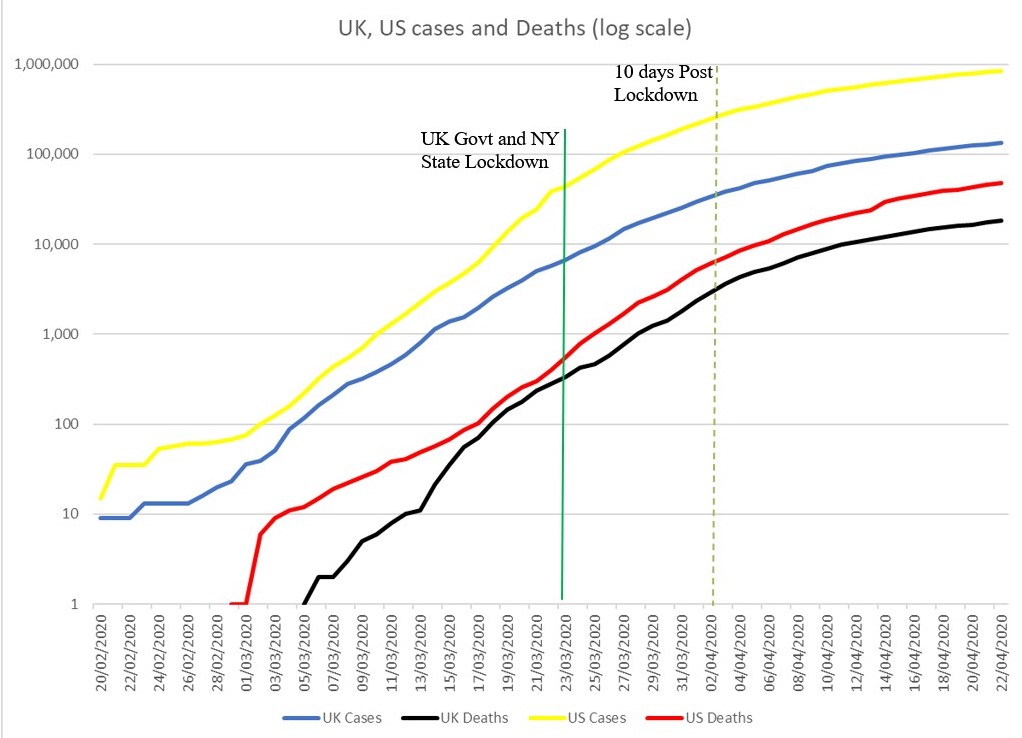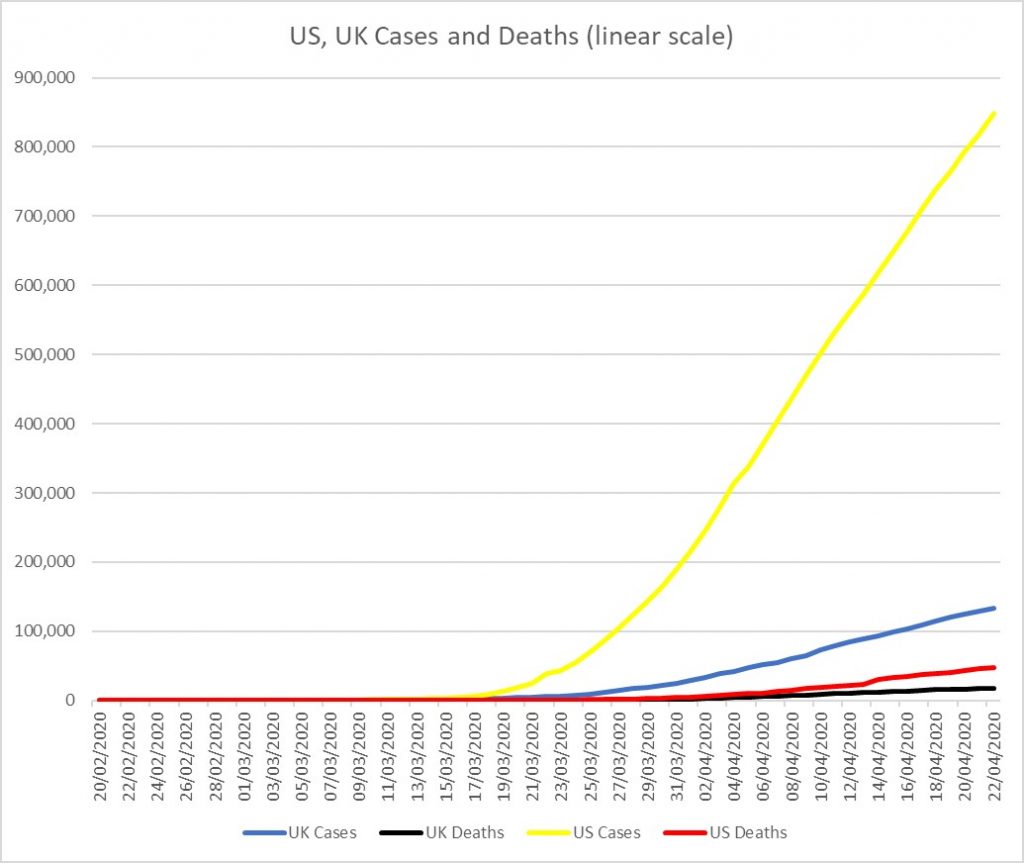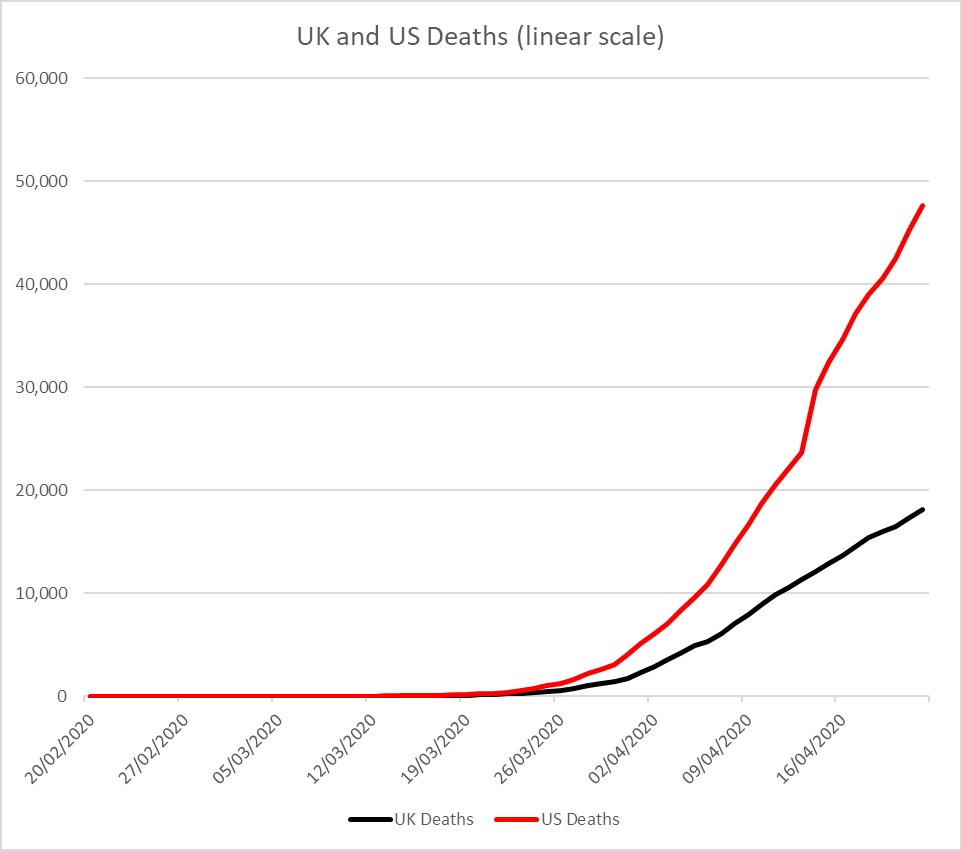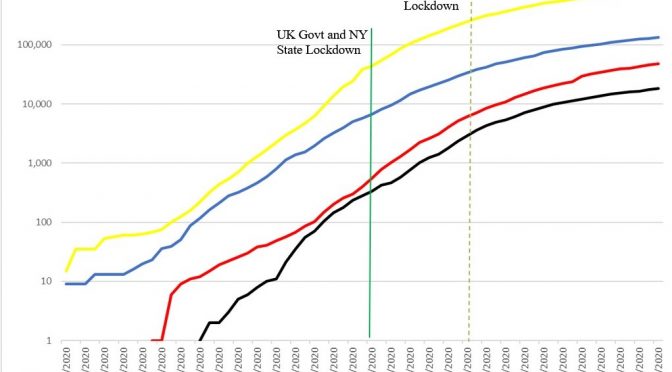As anticipated, the Coronavirus outbreak has definitively entered new phases in both the UK and the US, in the wake of ‘lockdown’ restrictions limiting non-essential production and consumption and encouraging populations to stay at home. These policies are centralised in the UK and State-wide in most of the US. As we can see from Chart 1 below, the log curve of cases and deaths is steadily flattening to the extent that we no longer have exponential growth of cases and deaths. It seems fairly clear that significant bending of the case curves took place after widespread social restrictions were imposed, and that the death curves followed with around a 10-day lag.

It’s too early to lift restrictions
It is utterly irresponsible to suggest, as many are doing (Trump supporters in the US and the usual Brexit suspects in the UK) that this means that we are in the clear and can now start to contemplate lifting restrictions on gathering socially, for work and on public transport. We do not have exponential growth, but despite all our efforts we still have steady linear growth in cases and deaths as indicated in Chart 2 below, and more clearly for deaths in Chart 3. Linear growth means that roughly constant numbers of people are acquiring the disease and are dying from it daily.

In the UK new positive tests are averaging around 5000 per day over the last 7 days, with confirmed deaths at around 750 per day.[1] In the US new test-positive cases have been arising at a rate of just under 29,000 per day and deaths at nearly 2200 per day for the last week. Assuming no further social restrictions, and that we are a long way from any herd immunity (should that be an achievable goal) we can expect these rates to remain pretty stable for a while.

Essentially, we are in an equilibrium where roughly as many are becoming ill as are dying or recovering. This implies that every infected person is transmitting the disease on average to one other person. (In technical epidemiological terms this mean that the R0 is around 1.) It also means that in the UK around 5000 people at a minimum will continue to die from Covid-19 every week, and in the US 15400 will die weekly. Bad as this is, it is unstable – any lifting of restrictions is likely to lift the R0 above 1 and return us again to exponential growth. It should be obvious that to do so is a bad idea, and that all efforts should instead be focussed on supporting those who are currently at a disadvantage from the restrictions, whether this is in monetary, social or educational form.
The charts above, combined with the evidence of the China epidemic described in my first Coronavirus blog, present strong prima facie evidence that the rate of growth of Covid-19 infection in the absence of measures to limit it is overwhelming, but that social restrictions are very effective in mitigation. Whether the overall mortality rate of Covid-19 turns out to be 0.1% or 1%, without those measures at least hundreds of thousands of people would have died, with accompanying healthcare chaos, over a few weeks. The fact that has not so far happened has no other plausible explanation than the ‘lockdown’ measures that have been taken. The estimates of community infection vary greatly, but nowhere are they anywhere near that required for ‘herd immunity’. Moreover, any policy arguments based on the concept of herd immunity – such as the idea that young people should be allowed to risk getting the infection while continuing to shield the elderly and ‘vulnerable’, are grossly premature. As yet we have very little idea of whether protective antibodies are formed following infection, and if they are, how long any consequent immunity might last.
Does Sweden offer an alternative policy model we should follow?
The example of Sweden is frequently cited as demonstrating that restrictive measures taken in the UK are excessive. In fact, while Sweden has stopped short of instructing citizens to stay at home, with the government favouring civic responsibility over mandatory rules, it has closed senior high schools and banned gatherings of more than 50 people. They have recommended rather than ordered people to avoid non-essential travel, work from home and to stay indoors if they are over 70 or feeling ill. Shops, restaurants and junior schools have stayed open, but with social-distancing rules in place. The main difference is perhaps less in what has changed as to how that has been achieved. The reality is that were the UK population to have rejected its government’s instructions enforcement would have been more or less impossible. We haven’t rejected it, not because we are a bunch of authority-loving sheep, but because we recognise, as do most Swedes, that limiting inter-personal contact to reduce virus transmission is basic common-sense. As it is, Sweden has many times more Covid-19 deaths (2021 at 23rd March) than its neighbours Norway (194) and Finland (172); these deaths continue to grow and there have been many deaths in care homes, which were supposedly protected. The hope in Sweden is that ‘herd immunity’ has built up so as to mitigate subsequent waves of infection, but as pointed out this depends on as yet unproven acquired immunity to the virus.
[1] The actual number of deaths directly due to Covid-19 may be as many as double those confirmed with testing. UK Office for National Statistics (ONS) data show deaths registered in the week to 10th April to be 75% above the 5-year average for England and Wales. The Financial Times has estimated this implies a total of over 40,000 excess deaths up to April 21st.
